Abstract
Fibrinogen degradation products (FDP) D and E are typically present in blood of patients with disseminated intravascular coagulation and related conditions in which granulocyte (PMN) defense against bacterial infection may be compromised. This study was intended to determine whether FDP modify PMN functions critical to their bactericidal activity. Incubation of human PMN and Escherichia coli with 50-100 micrograms/ml FDP did not affect phagocytosis, but reduced by greater than 90% the cells' ability to inhibit bacterial colony growth compared with control PMN incubated with albumin or fibrinogen. FDP (10-100 micrograms/ml) inhibited PMN O2- release and chemotaxis stimulated by FMLP by 17-50% (P less than 0.005) and 41% (P less than 0.01), respectively. Fragment E3, and not fragment D1, was primarily responsible for inhibition of FMLP-induced PMN O2- release. Phorbol myristate acetate (10 ng/ml), 1-oleoyl-2-acetylglycerol (10(-6) M), AA (4.2 x 10(-5) M), and zymosan-activated serum-stimulated PMN O2- release were also decreased 37-63% by FDP compared with control protein. There are at least two mechanisms by which FDP may impair PMN responses. With respect to FMLP, FDP (16-100 micrograms/ml) inhibited specific binding to the cell surface over a ligand concentration range of 1.4-85 nM [3H]FMLP. In contrast, FDP did not effect the extent of phorbol ester binding to PMN but blocked activation of protein kinase C. These data suggest that elevated plasma FDP inhibit several PMN functions critical to the bactericidal role of these inflammatory cells.
Full text
PDF
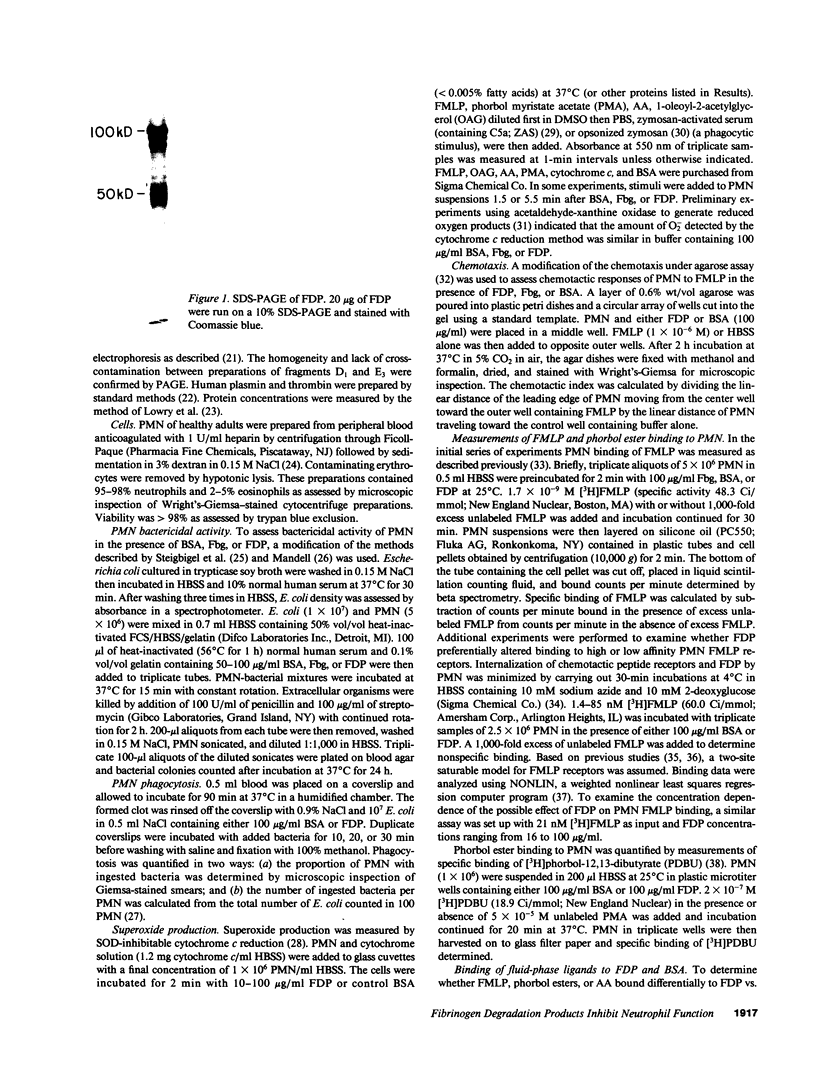
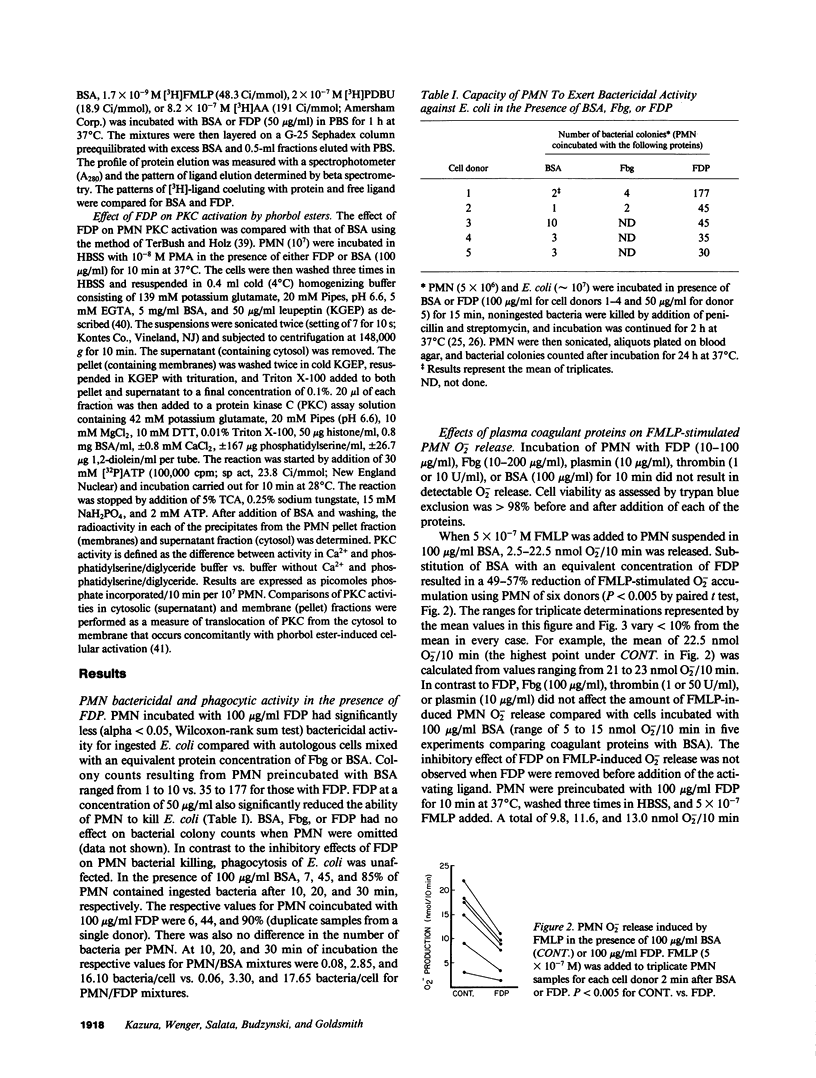
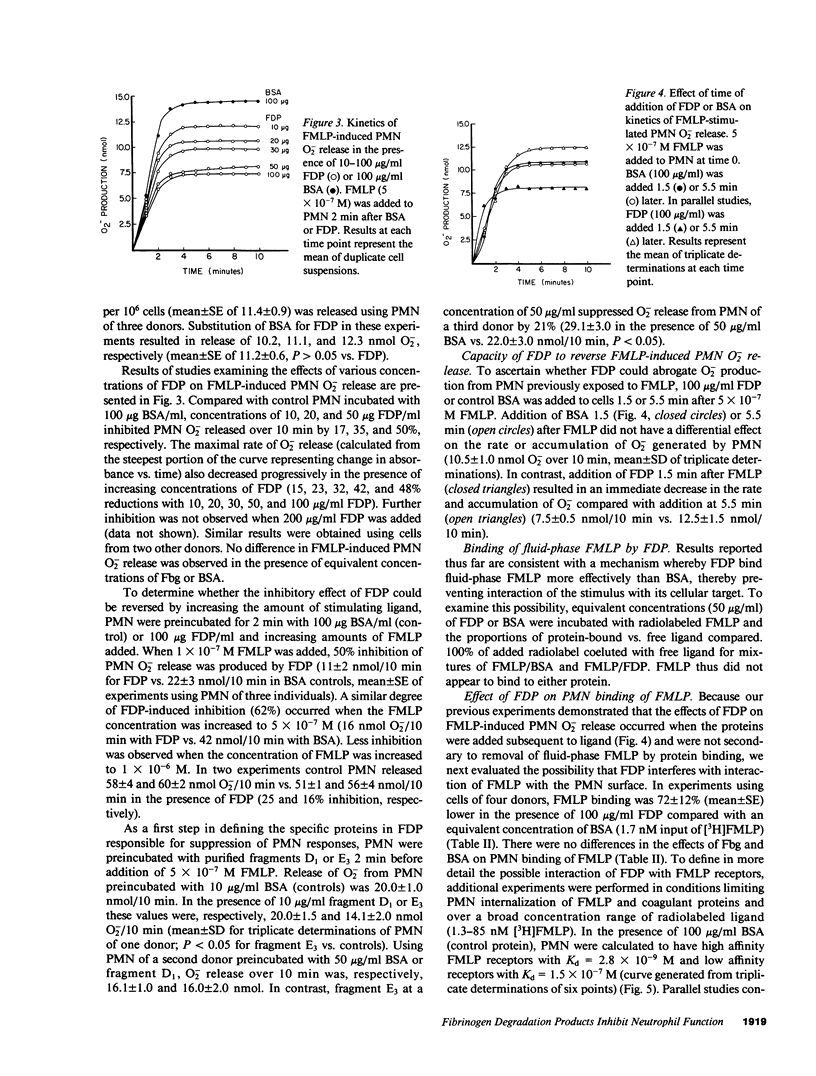
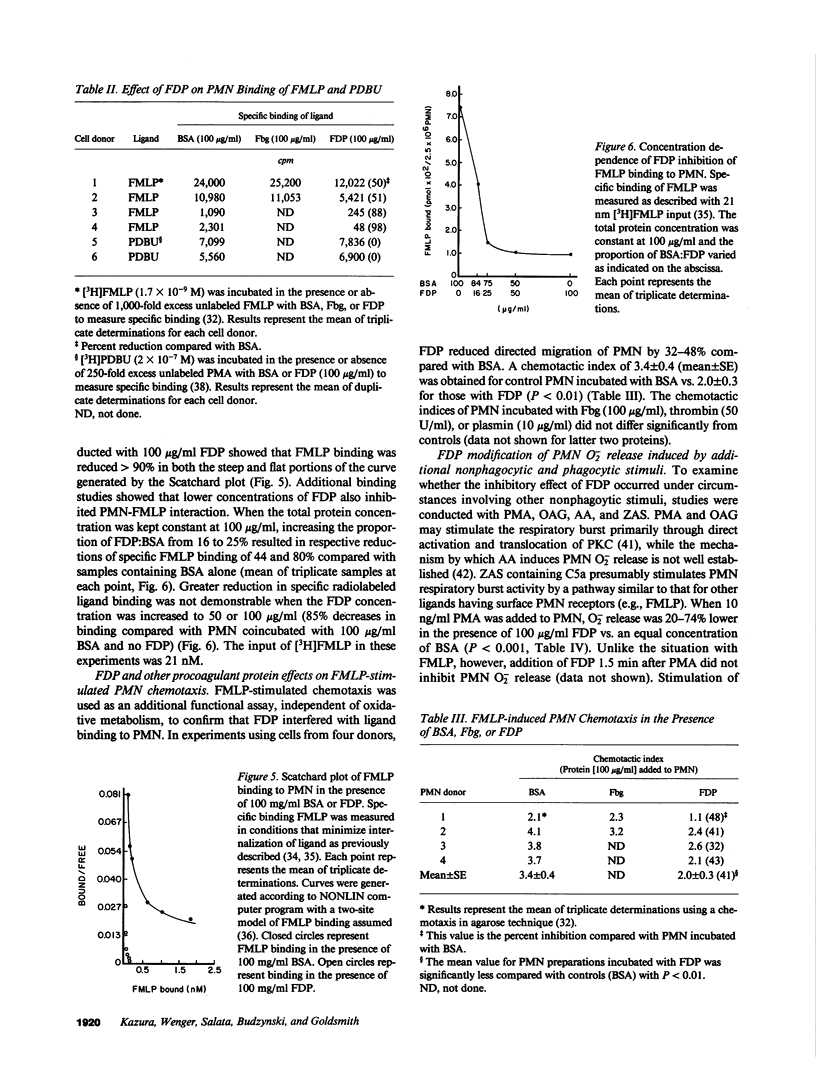
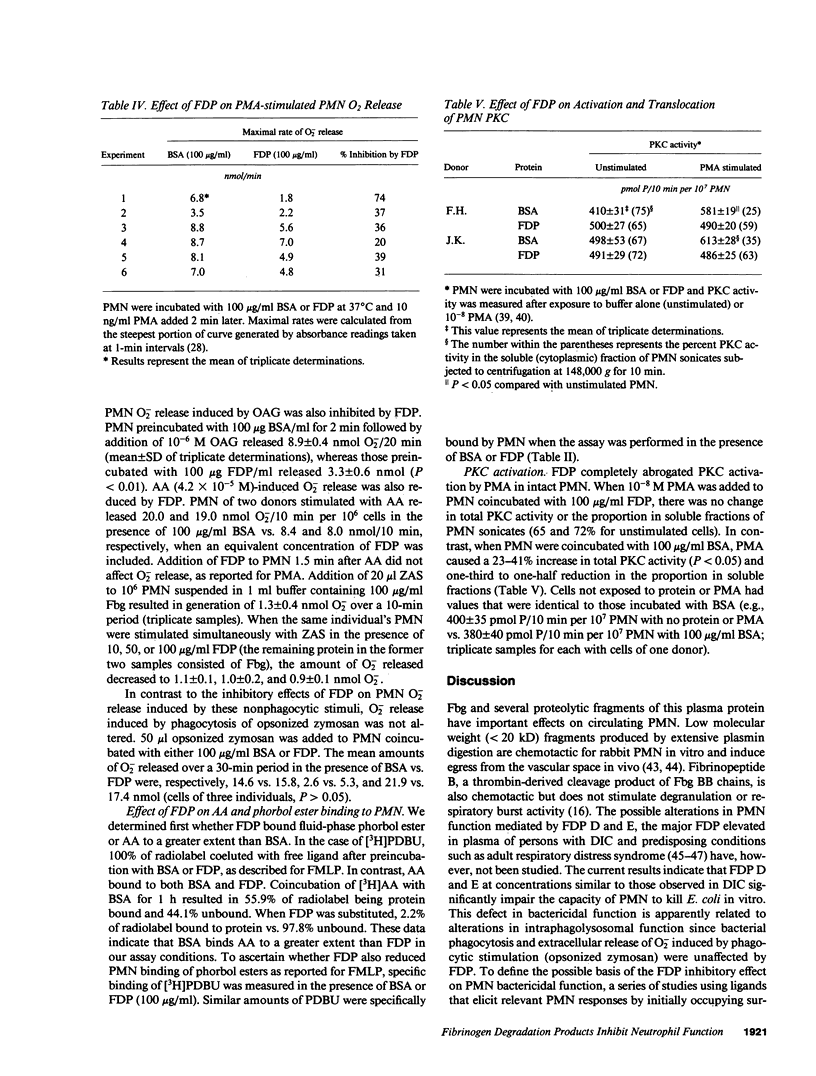
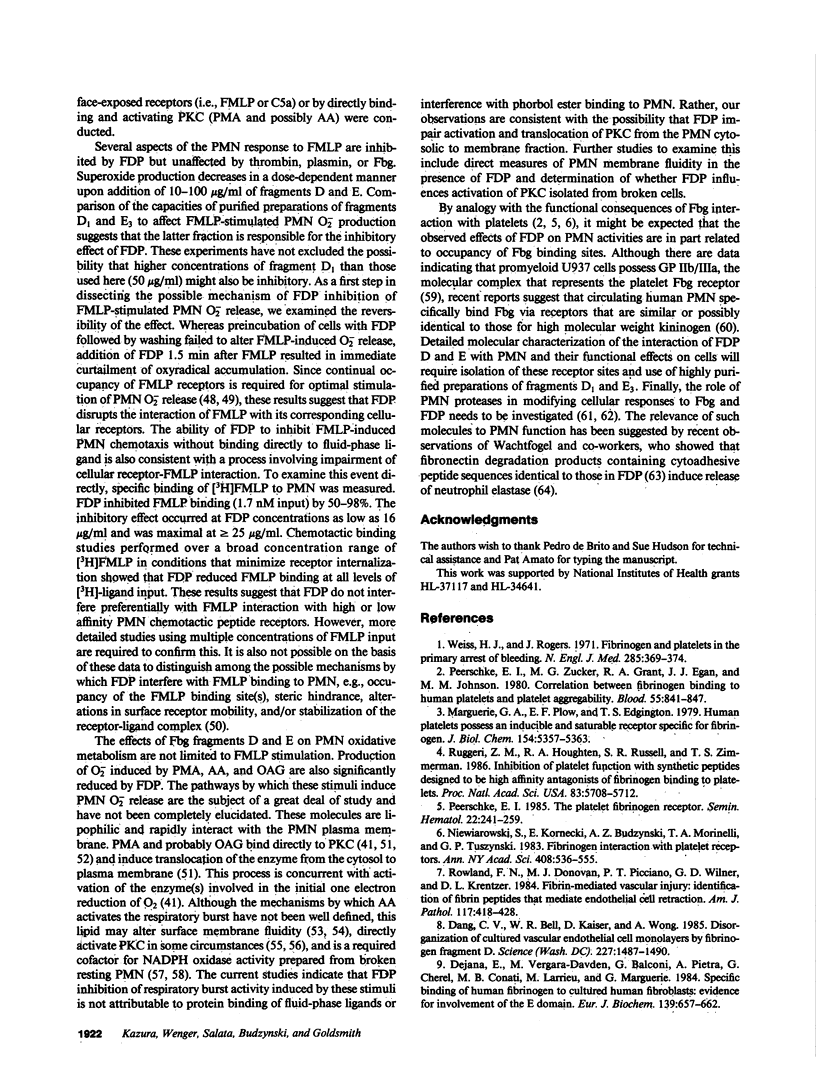
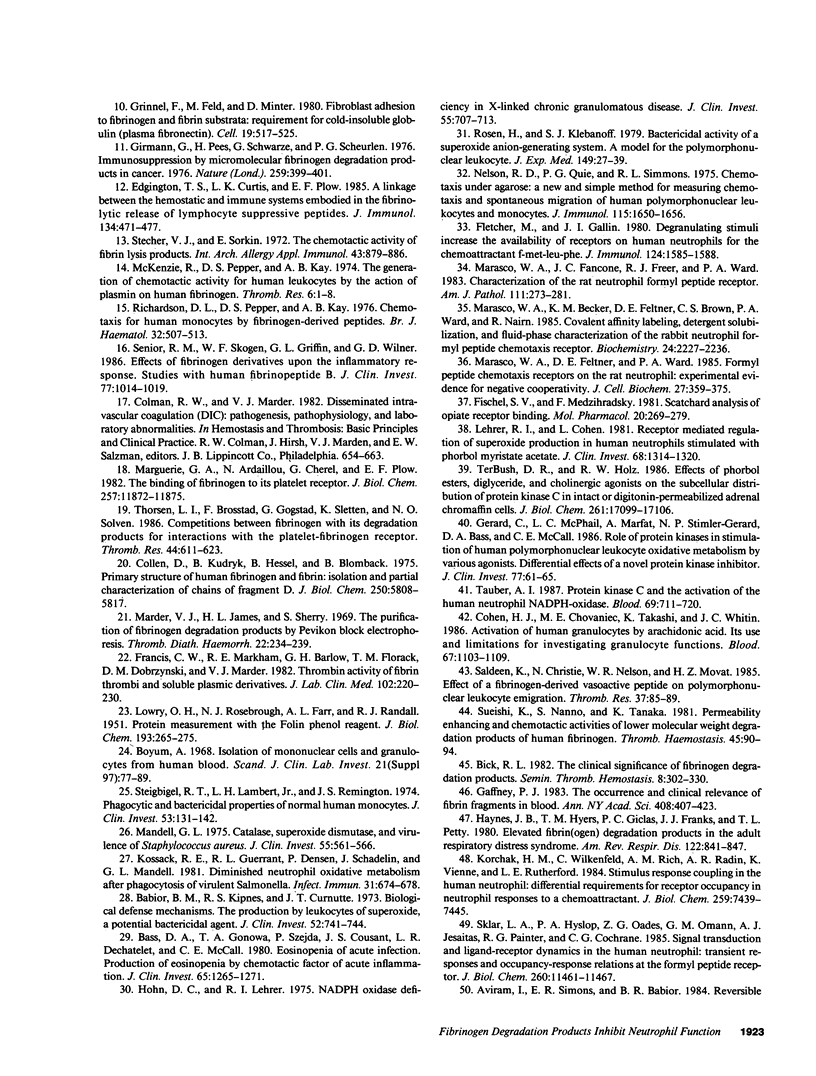
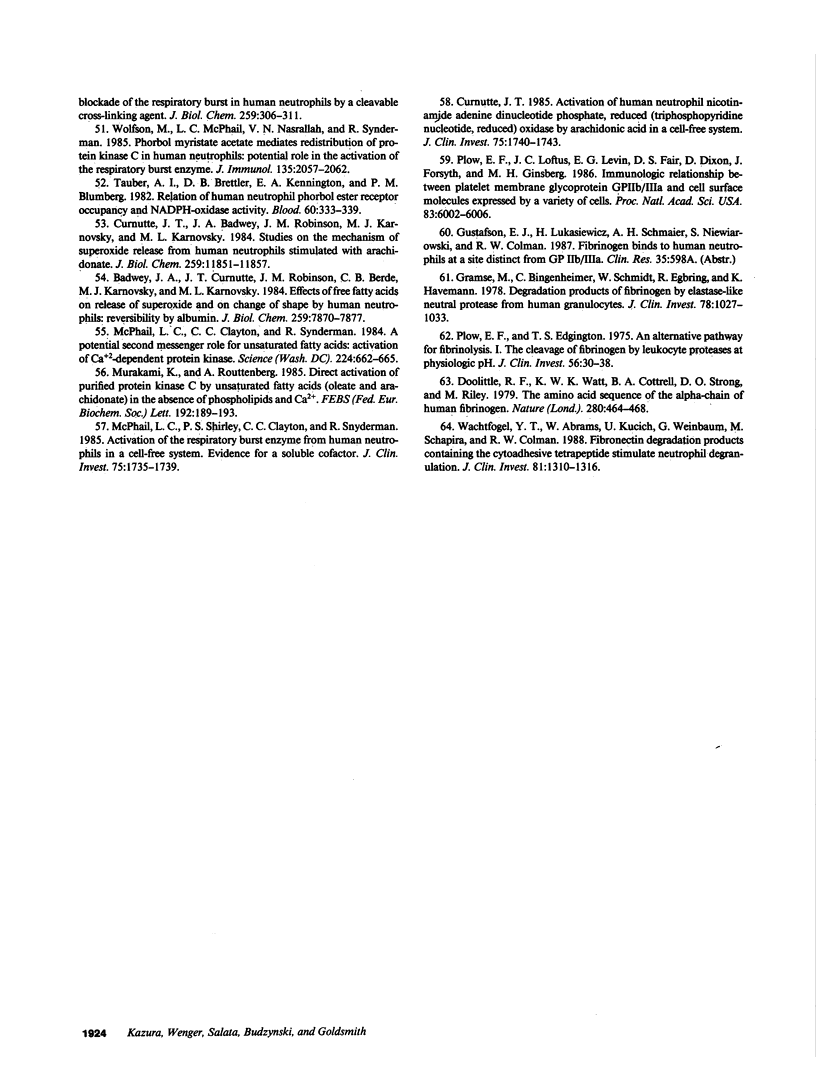
Images in this article
Selected References
These references are in PubMed. This may not be the complete list of references from this article.
- Babior B. M., Kipnes R. S., Curnutte J. T. Biological defense mechanisms. The production by leukocytes of superoxide, a potential bactericidal agent. J Clin Invest. 1973 Mar;52(3):741–744. doi: 10.1172/JCI107236. [DOI] [PMC free article] [PubMed] [Google Scholar]
- Badwey J. A., Curnutte J. T., Robinson J. M., Berde C. B., Karnovsky M. J., Karnovsky M. L. Effects of free fatty acids on release of superoxide and on change of shape by human neutrophils. Reversibility by albumin. J Biol Chem. 1984 Jun 25;259(12):7870–7877. [PubMed] [Google Scholar]
- Bass D. A., Gonwa T. A., Szejda P., Cousart M. S., DeChatelet L. R., McCall C. E. Eosinopenia of acute infection: Production of eosinopenia by chemotactic factors of acute inflammation. J Clin Invest. 1980 Jun;65(6):1265–1271. doi: 10.1172/JCI109789. [DOI] [PMC free article] [PubMed] [Google Scholar]
- Bick R. L. The clinical significance of fibrinogen degradation products. Semin Thromb Hemost. 1982 Oct;8(4):302–330. doi: 10.1055/s-2007-1005060. [DOI] [PubMed] [Google Scholar]
- Böyum A. Isolation of mononuclear cells and granulocytes from human blood. Isolation of monuclear cells by one centrifugation, and of granulocytes by combining centrifugation and sedimentation at 1 g. Scand J Clin Lab Invest Suppl. 1968;97:77–89. [PubMed] [Google Scholar]
- Cohen H. J., Chovaniec M. E., Takahashi K., Whitin J. C. Activation of human granulocytes by arachidonic acid: its use and limitations for investigating granulocyte functions. Blood. 1986 Apr;67(4):1103–1109. [PubMed] [Google Scholar]
- Collen D., Kudryk B., Hessel B., Blombäck B. Primary structure of human fibrinogen and fibrin. Isolation and partial characterization of chains of fragment D. J Biol Chem. 1975 Aug 10;250(15):5808–5817. [PubMed] [Google Scholar]
- Curnutte J. T. Activation of human neutrophil nicotinamide adenine dinucleotide phosphate, reduced (triphosphopyridine nucleotide, reduced) oxidase by arachidonic acid in a cell-free system. J Clin Invest. 1985 May;75(5):1740–1743. doi: 10.1172/JCI111885. [DOI] [PMC free article] [PubMed] [Google Scholar]
- Curnutte J. T., Badwey J. A., Robinson J. M., Karnovsky M. J., Karnovsky M. L. Studies on the mechanism of superoxide release from human neutrophils stimulated with arachidonate. J Biol Chem. 1984 Oct 10;259(19):11851–11857. [PubMed] [Google Scholar]
- Dang C. V., Bell W. R., Kaiser D., Wong A. Disorganization of cultured vascular endothelial cell monolayers by fibrinogen fragment D. Science. 1985 Mar 22;227(4693):1487–1490. doi: 10.1126/science.4038818. [DOI] [PubMed] [Google Scholar]
- Dejana E., Vergara-Dauden M., Balconi G., Pietra A., Cherel G., Donati M. B., Larrieu M. J., Marguerie G. Specific binding of human fibrinogen to cultured human fibroblasts. Evidence for the involvement of the E domain. Eur J Biochem. 1984 Mar 15;139(3):657–662. doi: 10.1111/j.1432-1033.1984.tb08054.x. [DOI] [PubMed] [Google Scholar]
- Doolittle R. F., Watt K. W., Cottrell B. A., Strong D. D., Riley M. The amino acid sequence of the alpha-chain of human fibrinogen. Nature. 1979 Aug 9;280(5722):464–468. doi: 10.1038/280464a0. [DOI] [PubMed] [Google Scholar]
- Edgington T. S., Curtiss L. K., Plow E. F. A linkage between the hemostatic and immune systems embodied in the fibrinolytic release of lymphocyte suppressive peptides. J Immunol. 1985 Jan;134(1):471–477. [PubMed] [Google Scholar]
- Fischel S. V., Medzihradsky F. Scatchard analysis of opiate receptor binding. Mol Pharmacol. 1981 Sep;20(2):269–279. [PubMed] [Google Scholar]
- Fletcher M. P., Gallin J. I. Degranulating stimuli increase the availability of receptors on human neutrophils for the chemoattractant f-met-leu-phe. J Immunol. 1980 Apr;124(4):1585–1588. [PubMed] [Google Scholar]
- Francis C. W., Markham R. E., Jr, Barlow G. H., Florack T. M., Dobrzynski D. M., Marder V. J. Thrombin activity of fibrin thrombi and soluble plasmic derivatives. J Lab Clin Med. 1983 Aug;102(2):220–230. [PubMed] [Google Scholar]
- Gaffney P. J. The occurrence and clinical relevance of fibrin fragments in blood. Ann N Y Acad Sci. 1983 Jun 27;408:407–423. doi: 10.1111/j.1749-6632.1983.tb23261.x. [DOI] [PubMed] [Google Scholar]
- Gerard C., McPhail L. C., Marfat A., Stimler-Gerard N. P., Bass D. A., McCall C. E. Role of protein kinases in stimulation of human polymorphonuclear leukocyte oxidative metabolism by various agonists. Differential effects of a novel protein kinase inhibitor. J Clin Invest. 1986 Jan;77(1):61–65. doi: 10.1172/JCI112302. [DOI] [PMC free article] [PubMed] [Google Scholar]
- Girmann G., Pees H., Schwarze G., Scheurlen P. G. Immunosuppression by micromolecular fibrinogen degradation products in cancer. Nature. 1976 Feb 5;259(5542):399–401. doi: 10.1038/259399a0. [DOI] [PubMed] [Google Scholar]
- Gramse M., Bingenheimer C., Schmidt W., Egbring R., Havemann K. Degradation products of fibrinogen by elastase-like neutral protease from human granulocytes. Characterization and effects on blood coagulation in vitro. J Clin Invest. 1978 Apr;61(4):1027–1033. doi: 10.1172/JCI109001. [DOI] [PMC free article] [PubMed] [Google Scholar]
- Grinnell F., Feld M., Minter D. Fibroblast adhesion to fibrinogen and fibrin substrata: requirement for cold-insoluble globulin (plasma fibronectin). Cell. 1980 Feb;19(2):517–525. doi: 10.1016/0092-8674(80)90526-7. [DOI] [PubMed] [Google Scholar]
- Haynes J. B., Hyers T. M., Giclas P. C., Franks J. J., Petty T. L. Elevated fibrin(ogen) degradation products in the adult respiratory distress syndrome. Am Rev Respir Dis. 1980 Dec;122(6):841–847. doi: 10.1164/arrd.1980.122.6.841. [DOI] [PubMed] [Google Scholar]
- Hohn D. C., Lehrer R. I. NADPH oxidase deficiency in X-linked chronic granulomatous disease. J Clin Invest. 1975 Apr;55(4):707–713. doi: 10.1172/JCI107980. [DOI] [PMC free article] [PubMed] [Google Scholar]
- Korchak H. M., Wilkenfeld C., Rich A. M., Radin A. R., Vienne K., Rutherford L. E. Stimulus response coupling in the human neutrophil. Differential requirements for receptor occupancy in neutrophil responses to a chemoattractant. J Biol Chem. 1984 Jun 25;259(12):7439–7445. [PubMed] [Google Scholar]
- Kossack R. E., Guerrant R. L., Densen P., Schadelin J., Mandell G. L. Diminished neutrophil oxidative metabolism after phagocytosis of virulent Salmonella typhi. Infect Immun. 1981 Feb;31(2):674–678. doi: 10.1128/iai.31.2.674-678.1981. [DOI] [PMC free article] [PubMed] [Google Scholar]
- LOWRY O. H., ROSEBROUGH N. J., FARR A. L., RANDALL R. J. Protein measurement with the Folin phenol reagent. J Biol Chem. 1951 Nov;193(1):265–275. [PubMed] [Google Scholar]
- Lehrer R. I., Cohen L. Receptor-mediated regulation of superoxide production in human neutrophils stimulated by phorbol myristate acetate. J Clin Invest. 1981 Nov;68(5):1314–1320. doi: 10.1172/JCI110378. [DOI] [PMC free article] [PubMed] [Google Scholar]
- Mandell G. L. Catalase, superoxide dismutase, and virulence of Staphylococcus aureus. In vitro and in vivo studies with emphasis on staphylococcal--leukocyte interaction. J Clin Invest. 1975 Mar;55(3):561–566. doi: 10.1172/JCI107963. [DOI] [PMC free article] [PubMed] [Google Scholar]
- Marasco W. A., Becker K. M., Feltner D. E., Brown C. S., Ward P. A., Nairn R. Covalent affinity labeling, detergent solubilization, and fluid-phase characterization of the rabbit neutrophil formyl peptide chemotaxis receptor. Biochemistry. 1985 Apr 23;24(9):2227–2236. doi: 10.1021/bi00330a017. [DOI] [PubMed] [Google Scholar]
- Marasco W. A., Fantone J. C., Freer R. J., Ward P. A. Characterization of the rat neutrophil formyl peptide chemotaxis receptor. Am J Pathol. 1983 Jun;111(3):273–281. [PMC free article] [PubMed] [Google Scholar]
- Marasco W. A., Feltner D. E., Ward P. A. Formyl peptide chemotaxis receptors on the rat neutrophil: experimental evidence for negative cooperativity. J Cell Biochem. 1985;27(4):359–375. doi: 10.1002/jcb.240270406. [DOI] [PubMed] [Google Scholar]
- Marder V. J., James H. L., Sherry S. The purification of fibrinogen degradation products by pevikon block electrophoresis. Thromb Diath Haemorrh. 1969 Nov 15;22(2):234–239. [PubMed] [Google Scholar]
- Marguerie G. A., Ardaillou N., Cherel G., Plow E. F. The binding of fibrinogen to its platelet receptor. J Biol Chem. 1982 Oct 25;257(20):11872–11875. [PubMed] [Google Scholar]
- Marguerie G. A., Plow E. F., Edgington T. S. Human platelets possess an inducible and saturable receptor specific for fibrinogen. J Biol Chem. 1979 Jun 25;254(12):5357–5363. [PubMed] [Google Scholar]
- McKenzie R., Pepper D. S., Kay A. B. The generation of chemotactic activity for human leukocytes by the action of plasmin on human fibrinogen. Thromb Res. 1975 Jan;6(1):1–8. doi: 10.1016/0049-3848(75)90145-0. [DOI] [PubMed] [Google Scholar]
- McPhail L. C., Shirley P. S., Clayton C. C., Snyderman R. Activation of the respiratory burst enzyme from human neutrophils in a cell-free system. Evidence for a soluble cofactor. J Clin Invest. 1985 May;75(5):1735–1739. doi: 10.1172/JCI111884. [DOI] [PMC free article] [PubMed] [Google Scholar]
- Murakami K., Routtenberg A. Direct activation of purified protein kinase C by unsaturated fatty acids (oleate and arachidonate) in the absence of phospholipids and Ca2+. FEBS Lett. 1985 Nov 18;192(2):189–193. doi: 10.1016/0014-5793(85)80105-8. [DOI] [PubMed] [Google Scholar]
- Nelson R. D., Quie P. G., Simmons R. L. Chemotaxis under agarose: a new and simple method for measuring chemotaxis and spontaneous migration of human polymorphonuclear leukocytes and monocytes. J Immunol. 1975 Dec;115(6):1650–1656. [PubMed] [Google Scholar]
- Niewiarowski S., Kornecki E., Budzynski A. Z., Morinelli T. A., Tuszynski G. P. Fibrinogen interaction with platelet receptors. Ann N Y Acad Sci. 1983 Jun 27;408:536–555. doi: 10.1111/j.1749-6632.1983.tb23271.x. [DOI] [PubMed] [Google Scholar]
- Peerschke E. I. The platelet fibrinogen receptor. Semin Hematol. 1985 Oct;22(4):241–259. [PubMed] [Google Scholar]
- Peerschke E. I., Zucker M. B., Grant R. A., Egan J. J., Johnson M. M. Correlation between fibrinogen binding to human platelets and platelet aggregability. Blood. 1980 May;55(5):841–847. [PubMed] [Google Scholar]
- Plow E. F., Edgington T. S. An alternative pathway for fibrinolysis. I. The cleavage of fibrinogen by leukocyte proteases at physiologic pH. J Clin Invest. 1975 Jul;56(1):30–38. doi: 10.1172/JCI108076. [DOI] [PMC free article] [PubMed] [Google Scholar]
- Plow E. F., Loftus J. C., Levin E. G., Fair D. S., Dixon D., Forsyth J., Ginsberg M. H. Immunologic relationship between platelet membrane glycoprotein GPIIb/IIIa and cell surface molecules expressed by a variety of cells. Proc Natl Acad Sci U S A. 1986 Aug;83(16):6002–6006. doi: 10.1073/pnas.83.16.6002. [DOI] [PMC free article] [PubMed] [Google Scholar]
- Richardson D. L., Pepper D. S., Kay A. B. Chemotaxis for human monocytes by fibrinogen-derived peptides. Br J Haematol. 1976 Apr;32(4):507–513. doi: 10.1111/j.1365-2141.1976.tb00953.x. [DOI] [PubMed] [Google Scholar]
- Rosen H., Klebanoff S. J. Bactericidal activity of a superoxide anion-generating system. A model for the polymorphonuclear leukocyte. J Exp Med. 1979 Jan 1;149(1):27–39. doi: 10.1084/jem.149.1.27. [DOI] [PMC free article] [PubMed] [Google Scholar]
- Rowland F. N., Donovan M. J., Picciano P. T., Wilner G. D., Kreutzer D. L. Fibrin-mediated vascular injury. Identification of fibrin peptides that mediate endothelial cell retraction. Am J Pathol. 1984 Dec;117(3):418–428. [PMC free article] [PubMed] [Google Scholar]
- Ruggeri Z. M., Houghten R. A., Russell S. R., Zimmerman T. S. Inhibition of platelet function with synthetic peptides designed to be high-affinity antagonists of fibrinogen binding to platelets. Proc Natl Acad Sci U S A. 1986 Aug;83(15):5708–5712. doi: 10.1073/pnas.83.15.5708. [DOI] [PMC free article] [PubMed] [Google Scholar]
- Saldeen K., Christie N., Nelson W. R., Movat H. Z. Effect of a fibrin(ogen)-derived vasoactive peptide on polymorphonuclear leukocyte emigration. Thromb Res. 1985 Jan 1;37(1):85–89. doi: 10.1016/0049-3848(85)90035-0. [DOI] [PubMed] [Google Scholar]
- Senior R. M., Skogen W. F., Griffin G. L., Wilner G. D. Effects of fibrinogen derivatives upon the inflammatory response. Studies with human fibrinopeptide B. J Clin Invest. 1986 Mar;77(3):1014–1019. doi: 10.1172/JCI112353. [DOI] [PMC free article] [PubMed] [Google Scholar]
- Sklar L. A., Hyslop P. A., Oades Z. G., Omann G. M., Jesaitis A. J., Painter R. G., Cochrane C. G. Signal transduction and ligand-receptor dynamics in the human neutrophil. Transient responses and occupancy-response relations at the formyl peptide receptor. J Biol Chem. 1985 Sep 25;260(21):11461–11467. [PubMed] [Google Scholar]
- Stecher V. J., Sorkin E. The chemotactic activity of fibrin lysis products. Int Arch Allergy Appl Immunol. 1972;43(6):879–886. doi: 10.1159/000230905. [DOI] [PubMed] [Google Scholar]
- Steigbigel R. T., Lambert L. H., Jr, Remington J. S. Phagocytic and bacterial properties of normal human monocytes. J Clin Invest. 1974 Jan;53(1):131–142. doi: 10.1172/JCI107531. [DOI] [PMC free article] [PubMed] [Google Scholar]
- Sueishi K., Nanno S., Tanaka K. Permeability enhancing and chemotactic activities of lower molecular weight degradation products of human fibrinogen. Thromb Haemost. 1981 Feb 23;45(1):90–94. [PubMed] [Google Scholar]
- Tauber A. I., Brettler D. B., Kennington E. A., Blumberg P. M. Relation of human neutrophil phorbol ester receptor occupancy and NADPH-oxidase activity. Blood. 1982 Aug;60(2):333–339. [PubMed] [Google Scholar]
- Tauber A. I. Protein kinase C and the activation of the human neutrophil NADPH-oxidase. Blood. 1987 Mar;69(3):711–720. [PubMed] [Google Scholar]
- TerBush D. R., Holz R. W. Effects of phorbol esters, diglyceride, and cholinergic agonists on the subcellular distribution of protein kinase C in intact or digitonin-permeabilized adrenal chromaffin cells. J Biol Chem. 1986 Dec 25;261(36):17099–17106. [PubMed] [Google Scholar]
- Thorsen L. I., Brosstad F., Gogstad G., Sletten K., Solum N. O. Competitions between fibrinogen with its degradation products for interactions with the platelet-fibrinogen receptor. Thromb Res. 1986 Dec 1;44(5):611–623. doi: 10.1016/0049-3848(86)90163-5. [DOI] [PubMed] [Google Scholar]
- Wachtfogel Y. T., Abrams W., Kucich U., Weinbaum G., Schapira M., Colman R. W. Fibronectin degradation products containing the cytoadhesive tetrapeptide stimulate human neutrophil degranulation. J Clin Invest. 1988 May;81(5):1310–1316. doi: 10.1172/JCI113456. [DOI] [PMC free article] [PubMed] [Google Scholar]
- Wolfson M., McPhail L. C., Nasrallah V. N., Snyderman R. Phorbol myristate acetate mediates redistribution of protein kinase C in human neutrophils: potential role in the activation of the respiratory burst enzyme. J Immunol. 1985 Sep;135(3):2057–2062. [PubMed] [Google Scholar]



